Looking for the best resources to expand your knowledge of solar energy? Look no further! In this article, we will explore the top 10 books on solar energy that cover a wide range of topics, from solar panel technology and design to renewable energy policy and economics. Whether you’re a seasoned professional in the solar industry or a newcomer interested in sustainable energy, these books offer valuable insights and practical information to help you navigate the world of solar power.
From comprehensive guides on solar photovoltaic systems to in-depth analyses of the solar industry’s impact on global energy markets, these books provide a wealth of information for anyone interested in harnessing the power of the sun. Whether you’re looking to install solar panels on your home or seeking to understand the broader implications of solar energy on a global scale, these top 10 solar energy books offer something for everyone. So, let’s dive into the world of solar energy literature and discover the essential reading material for anyone passionate about sustainable energy solutions.
Best Solar Energy Books
1. Mr. Michael Boxwell: Solar Electricity Handbook: A Simple Practical Guide to Solar Energy
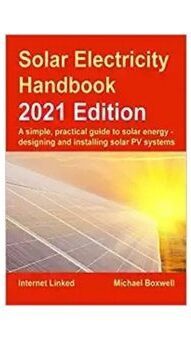
An excellent resource for the solar electrician and enthusiast, The Solar Electricity Handbook explains how you can use free energy from the sun to generate your electricity at home. Showing people how they can make their homes self-sufficient, includes everything you need to know about installing solar panels, whether on a flat roof or in your garden. With 3D diagrams and illustrations throughout, this book is an essential read for anyone who wants to generate electricity from the sun.
Hardcover: $34.29
Paperback: $19.99
The Author: Michael Boxwell has written about technology and the environment since 2003. His first book was The Proof of Delivery Buyer’s Guide, and he has since written the Solar Electricity Handbook (now in its eleventh edition) and The Electric Car Guide series of books.
2. Soteris A. Kalogirou: Solar Energy Engineering: Processes and Systems
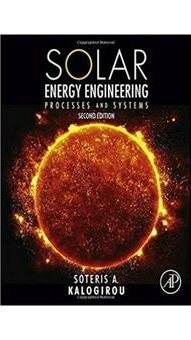
Solar Energy Engineering: Processes and Systems is the most comprehensive single-volume resource on solar energy engineering. It is an indispensable reference guide for anyone involved in the development and design of new solar energy systems. With expanded coverage of photovoltaic cells, and wind energy systems, and revised chapters on similar topics to previous editions, Solar Energy Engineering: Processes and Systems has been updated to reflect the latest advances in solar energy science and technology.
The book includes high-interest topics such as solar collectors, solar water heating, solar space heating and cooling, industrial process heat, photovoltaic technology, and solar thermal power systems and contains a new chapter on wind energy systems.
Hardcover: $108.98
The Author: Professor Soteris Kalogirou is the Dean of the School of Engineering and Technology at the Cyprus University of Technology in Limassol, Cyprus. He received his PhD from the University of Cambridge.
3. Ryan Mayfield: Photovoltaic Design and Installation
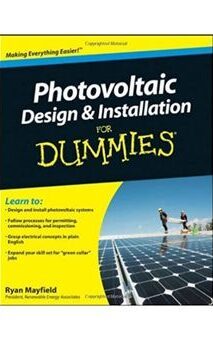
The cost of photovoltaic systems has been plunging in recent years and those price drops have further increased the popularity of solar installations. Understanding photovoltaic design is important for any homeowner desiring to invest in a solar installation.
Photovoltaic Design & Installation For Dummies gives you an understanding of the foundational courses required for entrance into an engineering or electrical program, as well as provides an introduction to the fundamental physics and math concepts required for designing photovoltaic systems.
Kindle: $15.00
Paperback: $35.89
The Author: Ryan Mayfield is the President of Renewable Energy Associates, a consulting firm providing design, support, and educational services for commercial photovoltaic systems.
4. Solar Energy International: Photovoltaics: Design and Installation Manual
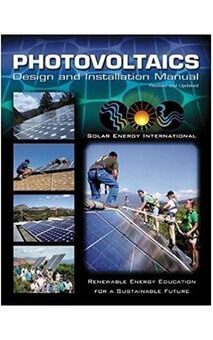
Solar energy conversion has become a major industry worldwide. Producing electricity from the sun using photovoltaic (PV) systems requires knowledge and training, and there have been few easily accessible guides on the subject.
Now, with the Photovoltaics: Design and Installation Manual, Solar Energy International (SEI)―a world-class solar energy training and education provider―has made available the critical information to successfully design and install PV systems. Included are chapters on sizing photovoltaic systems and analyzing sites before installing PV systems, as well as detailed appendices on maintenance, troubleshooting, and solar insolation data for over 300 sites around the world.
Paperback: $22
The Author: Solar Energy International (SEI) is a nonprofit organization that trains people in the use of solar energy. They offer hands-on workshops in many countries and online courses, too. Learn more about us or buy books and other learning tools directly from us at www.solarenergy.org
5. John Perlin: Let It Shine: The 6,000-Year Story of Solar Energy
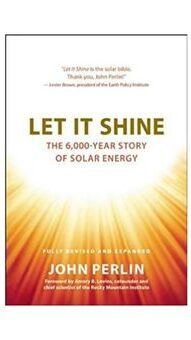
Let It Shine shares these with us to reveal the surprising extent to which humans have understood and harnessed sunlight, and the latest breakthroughs that may one day enable us to colonize space.
This book is a fascinating look at how people have used solar energy throughout time, how it relates to human development, and where we may be headed in our search for other planets where humans can live.
Hardcover: $18.95
Paperback: $24.95
The Author: John Perlin, a pioneer in solar history and technology, has been collecting anecdotes and stories about the sun from all around the globe for over forty years.
6. Andy Walker: Solar Energy: Technologies and Project Delivery for Buildings

Solar Energy: Technologies and Project Delivery for Buildings by Andy Walker is a comprehensive textbook on solar energy technologies and project delivery for buildings. It provides a conceptual foundation for the design of solar energy systems and presents detailed descriptions of the various technologies available.
With examples, technical explanations, sample documentation, and special tools that provide all the information needed for the complete design of a solar energy system for buildings to enable mainstream MEP and design firms, not just solar energy specialists.
Hardcover: $82.42
Paperback: $44.18
The Author: Andy Walker is a recognized authority on solar energy and a thought leader in the optimization of energy systems. He currently serves as Principal Engineer at the National Renewable Energy Laboratory, where he conducts engineering and economic analysis of energy efficiency projects for Federal agencies such as national parks and military bases. He also provides consulting services to commercial and industrial clients.
7. David Toth: The Sun King: From Retired Engineer To King Of Solar Power (Novel)

Against the wishes of his wife, who doesn’t want him to risk their comfort for an uncertain future, he invests everything he has into acquiring the assets and setting up his own solar power company with dreams of making it big by harnessing the sun’s energy for personal gain.
But David soon discovers that simply putting up solar panels isn’t enough; he must first gain acceptance from local regulators, then convince potential customers, who may not welcome competition from a brand new start-up out of nowhere.
If you love intrigue and suspense, this is the book for you. If you are an environmentalist, it will delight and enlighten you. If you are an entrepreneur, it will motivate and inspire you.
Kindle: $2.99
The Author: David Toth is a retired engineer living in the picturesque Adirondack Region of New York State. On a recent trip to his former employer, he learns that the company’s CEO is selling its solar business and urges him to consider taking over the operation. He immediately decides that this would be the perfect way for him to realize his long-dormant entrepreneurial dream.
8. Allan Fowler: Energy from the Sun: (Rookie Read-About Science: Earth Science) (For Kids)

Dive into the world of science with the energy from the sun. This book provides young readers with information about life on Earth and how it is affected by energy from the sun. With striking photographs and easy-to-read text, this book allows kids to learn about solar energy, why it is important, and how animals use it in their everyday lives.
Paperback: $11.40
The Author: Allan Fowler is the author of children’s books. In addition to his titles Can You See the Wind? and Sun’s Family of Planets (Rookie Read-About Science), he has also written Upside-Down Sloth and We Love Fruit.
9. Sean White: Solar Photovoltaic Basics
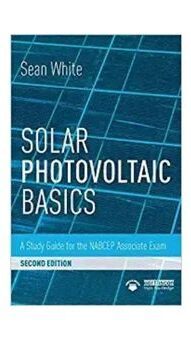
Get ahead in the solar industry by mastering the basics! Learn one of the most important and misunderstood technologies in our rapidly changing world. This book explains the science of photovoltaics (PV) in a way that most people can understand, using a curriculum that reflects the core modules of the NABCEP Associate Exam.
Whether or not you are taking this exam, learning the material covered here is an essential investment toward securing your place and moving up in your solar career. Full coverage of all ten NABCEP skill objectives ensures that you’ll be ready for any question they might throw at you on exam day, including PV Markets and Applications Safety Basics Electricity Basics Solar Energy Fundamentals PV Module Fundamentals System Components PV System Sizing Principles PV System Electrical Design Performance Analysis Maintenance Troubleshooting.
Hardcover: $127.00
Paperback: $23.91
10. Arno Smets: Solar Energy: The Physics and Engineering of Photovoltaic Conversion, Technologies, and Systems
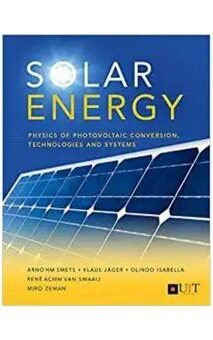
Solar energy is one of the most promising non-carbon technologies for climate change mitigation. However, the widespread adoption of solar photovoltaics (PV) is still challenged by cost and performance relative to fossil fuels. This book uniquely covers both the physics of photovoltaic (PV) cells and the design of PV systems for real-life applications, including: – The fundamental principles of semiconductor solar cells.
PV technology: crystalline silicon solar cells; thin-film cells; PV modules; third-generation concepts. – PV systems, from simple stand-alone to complex systems connected to the grid; components; design; deployment; performance. The book is an invaluable reference for researchers, industrial engineers, and designers working in solar energy generation. The book is also ideal for university and third-level physics or engineering courses on solar photovoltaics, with exercises to check students’ understanding and reinforce learning. It is the perfect companion to the Massive Open Online Course (MOOC) on Solar Energy presented by co-author Arno Smets.”
Paperback: $37.00
Solar Energy Definition
Solar energy is the radiant light and heat from the sun that reaches Earth. Solar energy can be harnessed through a range of ever-evolving technologies like solar heating, photovoltaics, solar thermal electricity, and solar architecture, which can provide benefits to the environment, as well as the economy.
Solar energy can be harnessed to provide electricity in a variety of ways. It also includes direct heating or cooling of water or air, usually done with the use of sunlight collected by a solar thermal collector or through a photovoltaic panel that transforms light into electrical energy. For solar energy to become more widely adopted, it must be cost-competitive with traditional methods of generating electricity. The efficiency of solar panels has increased dramatically over time – modern thin-film cells have an efficiency of up to 25%, while older conventional silicon cells have an efficiency of up to 17%.
Solar energy is clean and renewable, but it is also intermittent: most locations get only 6 to 7 hours of full sun per day. Worldwide there are now many large and small solar thermal power plants as well as solar water heaters. The largest solar thermal power plant in the world is located in California’s Mojave Desert.
Why Is Solar Energy Important?
The sun is one of the most abundant sources of energy on Earth. It provides us with more than enough energy to power our homes and businesses.
Solar energy is a clean, renewable resource that has the potential to supply all the world’s energy needs.
Solar power is now being used by homeowners, businesses, and utilities in every state around the country. As technology improves and costs continue to fall, solar power will become an increasingly important part of our country’s energy mix.
Here are some reasons why solar energy is so important:
Helps fight climate change – Burning fossil fuels for electricity releases greenhouse gases into the atmosphere that contribute to climate change. Switching to renewable sources like solar helps reduce these emissions by avoiding burning fossil fuels for electricity generation and transportation.
Protects our air quality – Solar power plants use no raw materials or water in their operations, reducing their environmental impact compared with conventional fuel-fired plants. They also emit no air pollutants or greenhouse gases during operation.
Reduces our dependence on foreign oil – Every 1 million kilowatt hours of electricity produced from coal-fired generation produces 4,900 pounds of carbon dioxide (CO2).
How To Learn Everything About Solar Energy?
There are several ways to learn everything about solar energy.
The first way is to visit your local library or bookstore and look for books on solar power. You will find many excellent texts that provide a wealth of information on this subject. You can also check out some websites that provide information on solar energy, such as the U.S. Department of Energy’s website at www1.eere.energy.gov/solar/.
Another way to learn more about solar energy is by talking with people who have experience with it. Many people who have installed solar panels in their homes are willing to share their experiences with you, and they may even offer advice on how to get started yourself.
Conclusion
This list includes some of the most interesting, informative, and enjoyable solar energy books. It covers several different topics ranging from choosing the right angle for your panels to the latest breakthroughs in solar technology. Once you have finished reading these books, don’t forget to share them with your friends.


